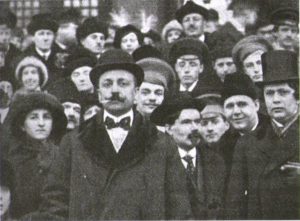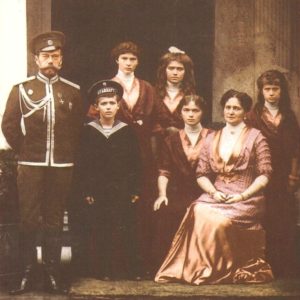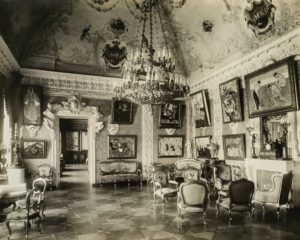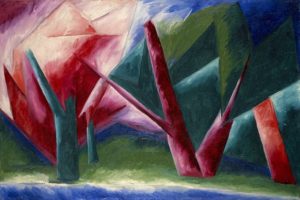What to do During a Revolution
The Death of Art
It is one of the oddities of modernism that the nations most attached to the past gave birth to movements that yearned most strongly for the future—but that longing for a new way of life cannot be a coincidence. Mired in the past, Italy and the Russian Empire were, by any standards, “backward,” a word universally used, when comparing them to the rest of Europe, to describe these two anachronistic and decrepit nations, clinging to the past and unsure of the way forward. And yet on the eve of the Great War, Italy and Russia had two admittedly small groups of avant-garde artists, writers and poets, the radical intelligentsia, straining to find modernity in places mired in the past. In the case of Russia, the sprawling ungovernable Empire, stretching like a growth, reaching out from west to east, the imperial government was ambivalent when it came to its relationship with the rest of Europe. Russia had a Western face, the side that struggled to modernize and adapt technology to its needs, but Russia also had an Eastern face, a deep consciousness of Russian exceptionalism or uniqueness. And it would be that backwards looking traditionalist face that would—ironically—fuel Russian Futurism—a contradiction in terms.

Marinetti in Moscow in 1914
When Futurism came to Russia, first as a word, a neologism implying all that which was modern and then later in the person of Marinetti, it was in the waning years of the anachronistic reign of an incompetent Czar. Marinetti was badly received by his Russian audiences in 1914, whose “Futurism” derived more from literature than from contact with actual Italian art. Little did he or any of the other Russian Avant-Garde artists, realize that that winter was the last before the Great War. Although the Futurists could not realize that the Empire could not survive such a massive social and cultural disruption, they were keenly aware of the anachronistic and insanely melodramatic nature of an illegitimate regime. The Czar, Nicholas II, was ruled by his vindictive and unstable wife, Alexandra and, through her allegiance to a mad monk, Grigori Yefimovich Rasputin, called “Rasputin,” the royal couple had allowed this unstable character to control the affairs of state. For whatever reason, Rasputin had managed convinced the parents that he alone could keep their precious child alive and cast a spell over the poor doomed child Alexia, heir to a throne he would never mount. The situation of the royal family sounded like a plot from a horror film but was, in fact, indicative of how insular Russia had become, going far off course, drifting away from modernity and moderation. The pointless and parasitic aristocrats, like the Royal Family served little purpose, but the nobles plotted against Rasputin and eventually managed to murder him in 1916.

Russian Royal Family
Rasputin and the drama in the Royal Family were symptomatic of deep internal instabilities within the Empire that could not be sustained. In order to hold on to its power, the regressive Russian Orthodox Church had deliberately held back the hands of time—literally, for, unlike the other nations of the so-called family of Queen Victoria, Russia refused to adopt the Julian calendar and rejected Greenwich Mean Time. In terms of time, Russia was in one place, the rest of the world was in a totally different time, all in the name of tradition and all things “Russian.” So hostile was the Empire to all things foreign that the railroads in Russia were of a gage different from those in Europe. Nevertheless, the counterweight to this deliberate refusal to dilute the uniqueness of the Empire was the life line to modern life was a paradox: the railway that stretched from Moscow to Paris. In the annals of art history, the fabled Moscow to Paris train carried Sergei Schchukin to the studios of Paris where the wealthy art collector scooped up the latest canvases from the ateliers of Matisse and Picasso, browse the galleries and carefully stowe his purchases on the train which carried the art back to Moscow.

Matisse paintings in Sergei Shchukin’s Trubetskoy Palace (1920)
Compared to Cubism, Futurism was, before the Great War, a brief movement, only two years and, during this short time could be seen only in Italy, France, Germany, and England, and, in 1915 and 1917 in America. No Futurist exhibition was ever mounted in Russia. Although it was possible to receive Cubism if one were an artist invited to Schchukin’s mansion, a more reliable conduit for West European avant-garde styles would be black and white reproductions seen in magazines and postcards. Dr. Konstantin Akinsha gave an interesting lecture at the Neue Galerie in New York in 1915 in which he described David Burliuk coming in to possession of a post card of a Cubist portrait by Picasso and how the artist immediately did a portrait of his own, telling himself to make it as “good as Picasso.” In addition to scattered reproductions, there were two catalogues of Futurist exhibitions circulating in Russia. With the exception of Russian expatriates in Paris, Russian artists in Moscow received Cubism and Futurism in black and white, a mode of replication which would stress line and structure and obliterating the subtleties of color or facture. As a result, the early responses to both styles on the part of Kazimir Malevich and Nataliya Goncharova were labored and naïve and literal, and it is only when the Russian artists appropriate the reproductions and transform Western styles into something uniquely Eastern and deeply Russian do the Russian avant-garde artists come into their own.

Nataliya Goncharova. The Forest (1913)
But if we follow the usual Modernist narrative, the Paris to Moscow tale, which has privileged French art, assuming that paintings from the familiar “isms” perpetrated in Paris brought “culture” to the Russians, we will see the “avant-garde,” and totally miss the “Russian” aspect of the art world. In fact, Futurism was already alive and well in Moscow before Cubism arrived, but this is a Futurism that was created at a great remove from Italy. It is important that it was in Moscow where so-called “Cubo-Futurism” and then “Suprematism” were invented, because this was a city deep inside Russia. In fact, when Lenin moved the capital from Petrograd to Moscow, it was not only because the port city was in danger during the civil war but also because having Moscow as the new capital sent a signal that Russia was no longer looking outward, towards the West and would turn inward, seeking its essence. The Russian artists, even before the Revolution, were dedicated to transforming the ideas coming in from Europe into Russian concepts or ideas that reflected the very nature of the Russian soul and mindset. Going back to the earlier statement that both Italy and Russia were technologically backward nations, carried into the twentieth century by a few pockets of modernism, the Futurists were interested in speed and dynamism in very literal ways, seeking to replicate the motion of fast objects, such as cars and trains, on the static canvas. The Russians, in contrast, translated the idea of “dynamism” into abstract forms, indicating a shift from the material to the spiritual.
Certainly, the Russians were aware that the pace of modern life was quickening and as in Italy this incursion of modernity would have been a sharp contrast to the motionless and becalmed regime of the Czar. The poet the poet Vladimir Mayakovsky remarked in 1914, on the edge of the Great War that, “In Russia the nervous life of cities demands quick, economical abrupt words.” It is important to stress that, in Russia, Futurism predated Italian Futurism and was always a linguistic exercise in finding a new form of expression. Kazimar Malevich (1878-1935) learned basic lessons of the appearance of the European avant-garde works in his series of paintings in the so-called “Cubo-Futurist” style but his understanding was surface only. These paintings, oddly enough, often focused on subjects that are anything but modern, the traditional Russian peasant. In foregrounding the peasant, Malevich was stressing his Russian heritage but there are political overtones as well in his presentation of a group long exploited by the government. The painting show that he was far removed from the theoretical underpinnings of either Cubism or Futurism and this separation allowed him to seize upon a visual vocabulary, rather than an intellectual concept, and translate Cubist semiotics and linguistics from an exploration of space and time to a leap into the spiritual realm. Suprematism, based upon the Latin word “supremus” which means “extreme” or “highest” and of course “supreme.” Malevich’s version of Cubism, especially his take on collage, did not rest upon fragmentation but upon the idea of combination.

Kazimir Malevich. Bureau and Room (1913)
For Malevich, Cubism was unsatisfactory, not just because its basis was strictly material, but also because any understanding of the style depended upon an exercise of logic in which the viewer accepted the premise that the object was being depicted from multiple points of view. But for the Russian artist, logic was limited and he sought something beyond logic, outside the materiality of the object itself. Malevich proposed a stance called the A-logic or the non-logical, stating, “The ‘Alogical’ movement has been created to free it from preconceptions.” In other words, the exercise of logic creates certain preconceptions which then limit thought and consequently burden art as well. The notion of the alogical was borrowed from the modern movement in poetry and referred to the “zaum” or the idea that words must be freed from their task of having to make meaning. The word, divested of its traditional role, could transcend spiritually. Malevich himself explained that his leap into the void of painting, manifested by the Black Square of 1913, was out of a desire to throw off the “ballast of objectivity.” Once Malevich had made the leap, he had launched his own personal premature Revolution, if you will, preceding the actual political changes just a few years in the future. As he said of Suprematism:
The Suprematist square and the forms proceeding out of it can be likened to the primitive marks (symbols) of aboriginal man which represented, in their combination, not ornament, but a feeling of rhythm. Suprematism did not bring into being a new world of feeling but, rather, an altogether new and direct form of representation of the world of feeling..The new art of Suprematism, which has produced new forms and form relationships by giving external expression to pictorial feeling, will become a new architecture: it will transfer these forms from the surface of canvas to space..Only with the disappearance of a habit of mind which sees in pictures little corners of nature, madonnas and shameless Venuses, shall we witness a work of pure, living art.

Kazimir Malevich. Self Portrait in two Dimensions (1915)
Thus the “zaum” and Surpremtist art were closely related to the idea of translational poetry, being developed in literary circles. The poet, Aleksey Kruchenykh, who was the first poet to use the non-word, “zaum,” explained in 1915, “Writing and reading must be instantaneous,”or in other words, visual, graspable at a glance. The notion of the fourth dimension, time, was a popular one, much buited in intellectual circles, and, like many artists early in the twentieth century, Malevich was interested in the possibility of totally freeing artistic forms from “objectivity” or reality. In creating what he called Sprematist “Zero Forms,” Malevich slipped the bonds of logic and was able to mobilize forms without any worldly reference points on to his canvases. The artist had complex and deeply felt concepts which explained and justified his extreme art, blank forms, so shocking at the time, and he invested an enormous amount of time in polishing his rarified positions. Out of the large group of Avant-Garde artists, Malevich had created his own uniquely Russian spiritually based approach to art. Without the competition of Mikhail Larionov and Nataliya Goncharova, after the Great War began, Malevich was the leader of the avant-garde in Moscow; a leader with followers and a new Russian style. But fate intervened, and a Revolution, political and social, suddenly exploded, demanding new art, an art that was practical and useful for the new state regime. After 1917, the fate of Malevich and his art was on the line.
If you have found this material useful, please give credit to
Dr. Jeanne S. M. Willette and Art History Unstuffed.
Thank you.